Overview
- Brief Narrative
- Ink drawing of large tree drawn by Ava Hegedish at the farm where she lived in hiding from spring 1941 to October 1944 near Belgrade, Yugoslavia (now Serbia.) In April 1941, Nazi Germany and its Axis partners partitioned Yugoslavia. Belgrade was under German control. Ava's father Leo decided the family's best chance of survival was to separate and go into hiding. He returned to Novy Sad; her mother and her sister Susanna remained in Belgrade. Susanna's Greek Orthodox husband had Serbian relatives with a farm near Belgrade and they agreed to take in Ava, then 15. She did farm labor and lived in this shed. To avoid suspicion and because she did not speak the local Serbian dialect, Ava pretended to be deaf and mute. She sometimes got scraps of paper and made drawings to hold onto her sense of self and her memories of her family. The region was liberated in October 1944. Ava searched for family in Belgrade. She learned that her sister was killed and her father murdered in Auschwitz. She was reunited with her mother and they settled in Belgrade where Ava attended art school.
- Artwork Title
- Tree near the Farm, 1941-1944
- Date
-
creation:
approximately 1941-approximately 1944
- Geography
-
creation:
in hiding;
Serbia
- Credit Line
- United States Holocaust Memorial Museum Collection, Gift of Ava Kadishson Schieber
- Signature
- bottom, ink : xe гепдшева [Ava Hegedish]
- Contributor
-
Artist:
Ava K. Schieber
Subject: Ava K. Schieber
- Biography
-
Ava Hegedish was born on April 12, 1926, in Novi Sad, Yugoslavia (now Serbia), to Leo and Beatrice Hegedish. This region along the Danube had been part of the Kingdom of Hungary under the Austro-Hungarian Empire. The Empire dissolved toward the end of the First World War (1914-1918) and the region became part of the newly created Yugoslavia. Ava’s father changed his surname around 1914 from Hirschel (Herschel} to Hegedish, a Hungarian sounding name, in order to receive a commission in the Austro-Hungarian Army in which he served during World War I. Hegedish resembled the Hungarian word for violinist, and Leo was a gifted amateur violinist. Leo was born in 1894 in Novi Sad; his mother’s name was Hermina and the family considered themselves Hungarian, as well as Jewish. Ava's mother Beatrice was born in Vienna, Austria. She was Roman Catholic, and converted to Judaism. Beatrice had two sisters, one, Stephanie, married a Jewish jeweler in Vienna. Beatrice and Leo met while she was traveling and shared a love of music. Ava had an older sister, Susanna, born in 1921. Novi Sad had only 4000 Jewish people in a city of 80,000. The majority of the population were Serbian Orthodox Christians. Leo was a successful businessman and the family lived a privileged life. Ava's family was active in their local synagogue. The girls attended the Jewish grammar school, which had such a high academic reputation that prominent non-Jewish families enrolled their children.
In March 1938, Germany annexed Austria; in March 1939, they invaded Czechoslovakia; and in September 1939, Poland. Fearing that Yugoslavia would soon be a target, around October 1939, Ava's family moved to the large captial city of Belgrade, where they had a better chance of blending in. They did not join a synagogue, to avoid being marked as Jews. Ava saw ships filled with Jewish refugees anchored in the middle of the Danube River after being refused entry to the port and soon forced to continue on their journey.
On April 6, 1941, Germany and its Axis partners, Italy, Hungary, and Bulgaria, invaded Yugoslavia. The country was dismembered: Germany annexed northern and east Slovenia and occupied most of Serbia. German troops arrived in Belgrade on April 12 and made it the headquarters for the military administration. The Germans began rounding up Jews and interning them in detention camps. All Jews were required to register with the German authorities. Ava’s father did not register the family and decided that their best chance for survival was to go into hiding separately. Leo, who looked Jewish and spoke poor Serbian, fled to Novi Sad, which had been annexed by Hungary, to help his mother Hermina. Ava's mother, Beatrice, still had her Roman Catholic birth certificate, and used it to register as a Catholic, likely under her maiden name. Susanna quickly and secretly married her Greek Orthodox fiance, and the priest falsified their marriage license, entering a prewar date. Susanna and Beatrice hid in different apartments around Belgrade.
Ava had no false papers, but her brother-in-law had Serbian relatives with a small farm about twelve miles away from Belgrade, who agreed to hide her. In return for refuge, Ava did manual labor. The blue eyed, blond haired Ava did not look Jewish, but she did not venture beyond the farm, as her city body language and education made her stand out in the peasant community. Ava had to pretend to be a deaf mute, since she did not speak or understand the local Serbian dialect. She lived in a shed between the chicken coop and the pig sty, with no running water, depending on rain water for drinking and washing. On impulse, Ava had brought her multivolume German encyclopedia, Meyer Lexicon, with her. The farm family was kind, but Ava was alone nearly all the time. These books reminded her of her old life and, she later recalled, became her anchor to sanity, even as, in her isolation, she felt she was losing her foothold. She was able to visit her mother and sister in the city only a few times. Ava had been compelled to draw from an early age. At the farm, she sometimes was able to get scraps of paper to make drawings. For Ava, drawing was a way to hold onto situations, feelings, and people, as well as her sense of self.
Ava lived on the farm for over three years. The region was liberated in October 1944 by Soviet forces. Ava returned to Belgrade to look for her family. She found the headquarters of the partisan and resistance groups, where she learned that her sister Susanna had been killed just before liberation. All of the registered Jews had been deported or killed. Ava decided to go to Novi Sad and obtained a travel permit at partisan headquarters. The commander of a Soviet Red Cross convoy agreed to let her travel with them. A Soviet medical office watched over her during the journey. He confided to her that he was Jewish and advised her not to tell anyone that she was a Jew. While walking down the street in Novi Sad, she met her best friend Ethel from before the war, who was not Jewish. Ethel was disgusted and made afraid by Ava's appearance and experiences and wanted nothing to do with her. Ava later met another friend who told her that her father Leo and her grandmother Hermina had been deported from Novi Sad by the German and Hungarian authorities to Auschwitz concentration camp and killed in 1944. Another friend later told her that her father had been forced to play in the Auschwitz camp orchestra. Before the end of the year, she was reunited with her mother Beatrice. Ava enrolled in the Belgrade Academy of Art and then got a scholarship to study set design at a film academy in Prague, Czechoslovakia. Ava worked as a set designer in film and theater in Belgrade.
In 1949, disliking Communist rule and the persistent antisemitism, Ava and Beatrice immigrated to Israel. Ava continued her career as a theater designer. She also began to exhibit her powerful, symbolic paintings expressing her feelings about the Holocaust. Ava married Yitzek Kadishson and worked with him at the Cameri Theater, an improvisational theater in Tel Aviv which he had co-founded. They had three children. Her mother passed away in Israel. Yitzek died in the early 1980s. Ava’s work has been shown in galleries throughout the US. She has published poems and stories about her ordeal, and given presentations to school and community groups. In 1985, Ava married Nathan Schieber (1916-1996) and settled in Chicago.
Physical Details
- Language
- Serbian
- Classification
-
Art
- Category
-
Drawings
- Object Type
-
Trees in art (lcsh)
- Physical Description
- Drawing in brown ink on paper with a perforated top edge of a tall, leafy tree with a large trunk and numerous, detailed branches, with bushy leaved ends. It stands centered at the edge of a dense forest of similar trees, bathed in light with shadows near the ground. It is signed in Serbian Cyrillic text.
- Dimensions
- overall: Height: 11.750 inches (29.845 cm) | Width: 8.000 inches (20.32 cm)
- Materials
- overall : paper, ink
Rights & Restrictions
- Conditions on Access
- No restrictions on access
- Conditions on Use
- Restrictions on use. Copyright status unknown.
Keywords & Subjects
Administrative Notes
- Legal Status
- Permanent Collection
- Provenance
- The drawing was donated to the United States Holocaust Memorial Museum in 2007 by Ava Kadishson Schieber.
- Funding Note
- The cataloging of this artifact has been supported by a grant from the Conference on Jewish Material Claims Against Germany.
- Record last modified:
- 2022-07-28 18:25:55
- This page:
- https://collections.ushmm.org/search/catalog/irn33652
Download & Licensing
In-Person Research
- By Appointment
- Request 21 Days in Advance of Visit
- Plan a Research Visit
- Request to See This Object
Contact Us
Also in Ava Kadishson Schieber collection
The collection consists of ten drawings and two paintings created by Ava Hegedish while living in hiding near Belgrade, Yugoslave, during the Holocaust.
Date: 1941-1944
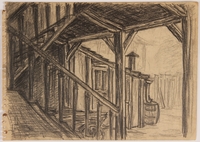
Drawing of her hiding place by a Jewish teenager
Object
Pencil drawing of a wooden shed by Ava Hegedish where she lived in hiding on a farm from spring 1941 to October 1944 near Belgrade, Yugoslavia (now Serbia.) In April 1941, Nazi Germany and its Axis partners partitioned Yugoslavia. Belgrade was under German control. Ava's father Leo decided the family's best chance of survival was to separate and go into hiding. He returned to Novy Sad; her mother and her sister Susanna remained in Belgrade. Susanna's Greek Orthodox husband had Serbian relatives with a farm near Belgrade and they agreed to take in Ava, then 15. She did farm labor and lived in this shed. To avoid suspicion and because she did not speak the local Serbian dialect, Ava pretended to be deaf and mute. She sometimes got scraps of paper and made drawings to hold onto her sense of self and her memories of her family. The region was liberated in October 1944. Ava searched for family in Belgrade. She learned that her sister was killed and her father murdered in Auschwitz. She was reunited with her mother and they settled in Belgrade where Ava attended art school.
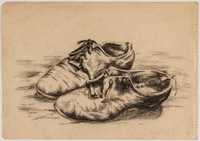
Drawing of her mother's shoes by a Jewish teenager in hiding
Object
Pencil drawing of a worn pair of her mother's shoes drawn by Ava Hegedish at the farm where she lived in hiding from spring 1941 to October 1944 near Belgrade, Yugoslavia (now Serbia.) In April 1941, Nazi Germany and its Axis partners partitioned Yugoslavia. Belgrade was under German control. Ava's father Leo decided the family's best chance of survival was to separate and go into hiding. He returned to Novy Sad; her mother and her sister Susanna remained in Belgrade. Susanna's Greek Orthodox husband had Serbian relatives with a farm near Belgrade and they agreed to take in Ava, then 15. She did farm labor and lived in this shed. To avoid suspicion and because she did not speak the local Serbian dialect, Ava pretended to be deaf and mute. She sometimes got scraps of paper and made drawings to hold onto her sense of self and her memories of her family. The region was liberated in October 1944. Ava searched for family in Belgrade. She learned that her sister was killed and her father murdered in Auschwitz. She was reunited with her mother and they settled in Belgrade where Ava attended art school.
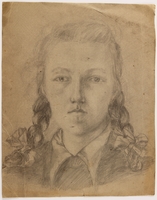
Self portrait with braids by a Jewish teenager in hiding
Object
Self portrait drawn by Ava Hegedish at the farm where she lived in hiding from spring 1941 to October 1944 near Belgrade, Yugoslavia (now Serbia.) In April 1941, Nazi Germany and its Axis partners partitioned Yugoslavia. Belgrade was under German control. Ava's father Leo decided the family's best chance of survival was to separate and go into hiding. He returned to Novy Sad; her mother and her sister Susanna remained in Belgrade. Susanna's Greek Orthodox husband had Serbian relatives with a farm near Belgrade and they agreed to take in Ava, then 15. She did farm labor and lived in this shed. To avoid suspicion and because she did not speak the local Serbian dialect, Ava pretended to be deaf and mute. She sometimes got scraps of paper and made drawings to hold onto her sense of self and her memories of her family. The region was liberated in October 1944. Ava searched for family in Belgrade. She learned that her sister was killed and her father murdered in Auschwitz. She was reunited with her mother and they settled in Belgrade where Ava attended art school.
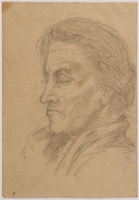
Drawing of her grandmother in profile created by Jewish teenage girl in hiding
Object
Pencil drawing of her paternal grandmother, Hermina Hirschel, drawn by Ava Hegedish at the farm where she lived in hiding from spring 1941 to October 1944 near Belgrade, Yugoslavia (now Serbia.) Ava also did an oil painting of her, 2007.521.4. In April 1941, Nazi Germany and its Axis partners partitioned Yugoslavia. Belgrade was under German control. Ava's father Leo decided the family's best chance of survival was to separate and go into hiding. He returned to Novy Sad; her mother and her sister Susanna remained in Belgrade. Susanna's Greek Orthodox husband had Serbian relatives with a farm near Belgrade and they agreed to take in Ava, then 15. She did farm labor and lived in this shed. To avoid suspicion and because she did not speak the local Serbian dialect, Ava pretended to be deaf and mute. She sometimes got scraps of paper and made drawings to hold onto her sense of self and her memories of her family. The region was liberated in October 1944. Ava searched for family in Belgrade. She learned that her sister was killed and her father murdered in Auschwitz. She was reunited with her mother and they settled in Belgrade where Ava attended art school.
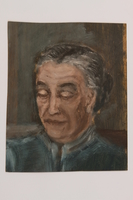
Oil portrait of her grandmother by a Jewish teenager in hiding
Object
Oil painting of her paternal grandmother, Hermina Hirschel, painted by Ava Hegedish in 1941, when she lived in hiding from spring 1941 to October 1944 near Belgrade, Yugoslavia (now Serbia.) Ava also did a oil portrait of her, 2007.521.4. In April 1941, Nazi Germany and its Axis partners partitioned Yugoslavia. Belgrade was under German control. Ava's father Leo decided the family's best chance of survival was to separate and go into hiding. He returned to Novy Sad; her mother and her sister Susanna remained in Belgrade. Susanna's Greek Orthodox husband had Serbian relatives with a farm near Belgrade and they agreed to take in Ava, then 15. She did farm labor and lived in this shed. To avoid suspicion and because she did not speak the local Serbian dialect, Ava pretended to be deaf and mute. She sometimes got scraps of paper and made drawings to hold onto her sense of self and her memories of her family. The region was liberated in October 1944. Ava searched for family in Belgrade. She learned that her sister was killed and her father murdered in Auschwitz. She was reunited with her mother and they settled in Belgrade where Ava attended art school.
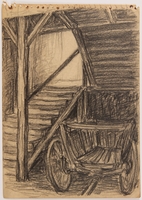
Drawing of the stairway near her hiding place by Jewish teenager
Object
Pencil drawing of steps near a wooden wagon drawn by Ava Hegedish at the farm where she lived in hiding from spring 1941 to October 1944 near Belgrade, Yugoslavia (now Serbia.) The wooden shack where she lived was nearby. In April 1941, Nazi Germany and its Axis partners partitioned Yugoslavia. Belgrade was under German control. Ava's father Leo decided the family's best chance of survival was to separate and go into hiding. He returned to Novy Sad; her mother and her sister Susanna remained in Belgrade. Susanna's Greek Orthodox husband had Serbian relatives with a farm near Belgrade and they agreed to take in Ava, then 15. She did farm labor and lived in this shed. To avoid suspicion and because she did not speak the local Serbian dialect, Ava pretended to be deaf and mute. She sometimes got scraps of paper and made drawings to hold onto her sense of self and her memories of her family. The region was liberated in October 1944. Ava searched for family in Belgrade. She learned that her sister was killed and her father murdered in Auschwitz. She was reunited with her mother and they settled in Belgrade where Ava attended art school.
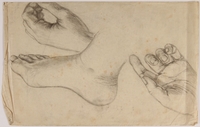
Sketches of a foot and 2 hands done in hiding by Jewish teenager
Object
Pencil drawings of a foot and two hands done by Ava Hegedish, at the farm where she lived in hiding from spring 1941 to October 1944 near Belgrade, Yugoslavia (now Serbia.) In April 1941, Nazi Germany and its Axis partners partitioned Yugoslavia. Belgrade was under German control. Ava's father Leo decided the family's best chance of survival was to separate and go into hiding. He returned to Novy Sad; her mother and her sister Susanna remained in Belgrade. Susanna's Greek Orthodox husband had Serbian relatives with a farm near Belgrade and they agreed to take in Ava, then 15. She did farm labor and lived in this shed. To avoid suspicion and because she did not speak the local Serbian dialect, Ava pretended to be deaf and mute. She sometimes got scraps of paper and made drawings to hold onto her sense of self and her memories of her family. The region was liberated in October 1944. Ava searched for family in Belgrade. She learned that her sister was killed and her father murdered in Auschwitz. She was reunited with her mother and they settled in Belgrade where Ava attended art school.
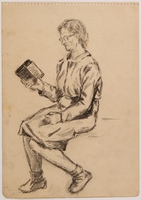
Portrait of her mother reading a book by a Jewish artist
Object
Pencil drawing of her mother, Beatrice Hegedish, drawn by Ava Hegedish, ca. 1942-1943, on one of their rare visits in Belgrade during the war after the family went into hiding in spring 1941. In April 1941, Nazi Germany and its Axis partners partitioned Yugoslavia. Belgrade was under German control. Ava's father Leo decided the family's best chance of survival was to separate and go into hiding. He returned to Novy Sad; her mother and her sister Susanna remained in Belgrade. Susanna's Greek Orthodox husband had Serbian relatives with a farm near Belgrade and they agreed to take in Ava, then 15. She did farm labor and lived in this shed. To avoid suspicion and because she did not speak the local Serbian dialect, Ava pretended to be deaf and mute. She sometimes got scraps of paper and made drawings to hold onto her sense of self and her memories of her family. The region was liberated in October 1944. Ava searched for family in Belgrade. She learned that her sister was killed and her father murdered in Auschwitz. She was reunited with her mother and they settled in Belgrade where Ava attended art school.
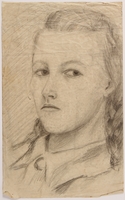
Self-portrait of a young woman looking sideways by a Jewish teenager in hiding
Object
Self portrait in pencil drawn by Ava Hegedish when, from age 15 to 18, she lived in hiding at the farm of a Serbian Christian peasant family near Belgrade, Yugoslavia (now Serbia.) In April 1941, Nazi Germany and its Axis partners partitioned Yugoslavia. Belgrade was under German control. Ava's father Leo decided the family's best chance of survival was to separate and go into hiding. He returned to Novy Sad; her mother and her sister Susanna remained in Belgrade. Susanna's Greek Orthodox husband had Serbian relatives with a farm near Belgrade and they agreed to take in Ava, then 15. She did farm labor and lived in this shed. To avoid suspicion and because she did not speak the local Serbian dialect, Ava pretended to be deaf and mute. She sometimes got scraps of paper and made drawings to hold onto her sense of self and her memories of her family. The region was liberated in October 1944. Ava searched for family in Belgrade. She learned that her sister was killed and her father murdered in Auschwitz. She was reunited with her mother and they settled in Belgrade where Ava attended art school.
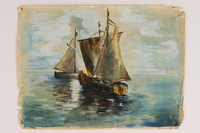
Watercolor of sailboats of Jewish refugees painted by a Jewish woman artist
Object
Watercolor of sailboats on the Danube River painted by Ava Hegedish in 1941, just before or while living in hiding near Belgrade, Yugoslavia. The painting depicts the ships filled with Jewish refugees from Austria, Germany, and Czechoslovakia that she saw anchored in the middle of the river in the late 1930s-early 1940s. They were not permitted to enter port and were forced to continue their journey to the Black Sea where Ava believed they perished. She thought of them as ghost ships. The Jewish community sent food and clothing to the ships, and sometimes the students who delivered the supplies were not allowed to return to Belgrade. In April 1941, Germany and the Axis partners partitioned Yugoslavia. Belgrade was under German control. Ava's father Leo decided the family's best chance of survival was to separate and go into hiding. He returned to Novy Sad. Ava's mother Beatrice and Ava's older sister Susanna remained in Belgrade. Susanna's Greek Orthodox husband had Serbian relatives with a farm near Belgrade and they agreed to take in Ava, then 15. She did farm labor and, to avoid suspicion and because she did not speak the local Serbian dialect, pretend to be deaf and mute. Ava sometimes got scraps of paper and made drawings to hold onto her sense of self and her memories of her family. The region was liberated in October 1944. Ava searched for family and learned that her sister was killed and her father and his mother were murdered in Auschwitz. She was reunited with her mother and they settled in Belgrade where Ava attended art school.
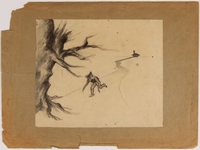
Fantasy sketch of a figure running to a tree by a Jewish teen in hiding
Object
Pencil drawing of a large leafless tree and a mysterious figure drawn by Ava Hegedish at the farm where she lived in hiding from spring 1941 to October 1944 near Belgrade, Yugoslavia (now Serbia.) In April 1941, Germany and the Axis partners partitioned Yugoslavia. Belgrade was under German control. Jews were ordered to register, and Ava's father Leo decided the family's best chance of survival was to separate and go into hiding. He returned to Novy Sad. Ava's mother got false papers and remained in Belgrade with Ava's older sister Susanna, who married her Greek Orthodox fiance. The fiance had Serbian relatives with a farm near Belgrade and they agreed to take in Ava, then 15. She did farm labor and, to avoid suspicion and because she did not speak the local Serbian dialect, pretended to be deaf and mute. Ava sometimes got scraps of paper and made drawings to hold onto her sense of self and her memories of her family. The region was liberated in October 1944. Ava searched for family and learned that her sister was killed and her father and his mother were murdered in Auschwitz. She was reunited with her mother and they settled in Belgrade.



